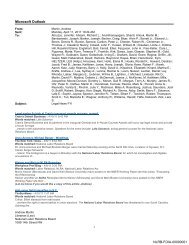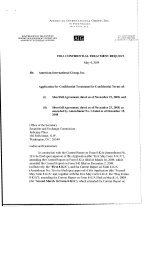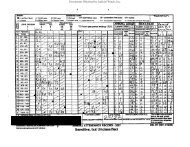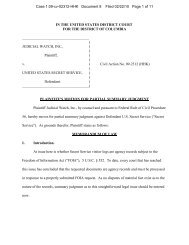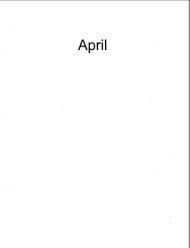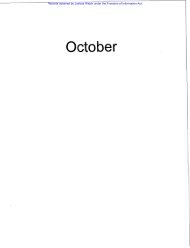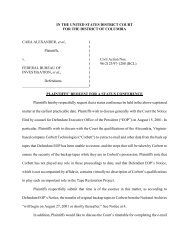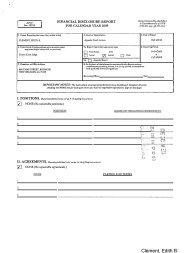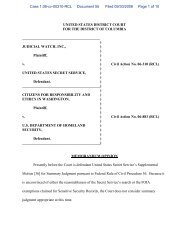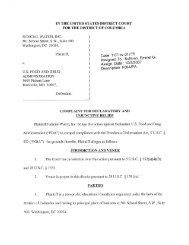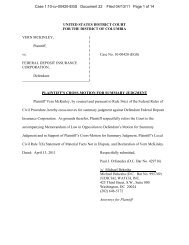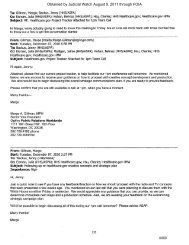Plaintiff's Surreply to Defendant's Motion for ... - Judicial Watch
Plaintiff's Surreply to Defendant's Motion for ... - Judicial Watch
Plaintiff's Surreply to Defendant's Motion for ... - Judicial Watch
- No tags were found...
Create successful ePaper yourself
Turn your PDF publications into a flip-book with our unique Google optimized e-Paper software.
IN THE UNITED STATES DISTRICT COURT<br />
FOR THE DISTRICT OF COLUMBIA<br />
JUDICIAL WATCH, INC., )<br />
)<br />
Plaintiff, )<br />
) C.A. No. 1:06CV00406 (HHK)<br />
v. )<br />
)<br />
U.S. DEPARTMENT OF JUSTICE, )<br />
)<br />
Defendant. )<br />
____________________________________)<br />
PLAINTIFF’S MOTION FOR LEAVE TO FILE SURREPLY<br />
Plaintiff <strong>Judicial</strong> <strong>Watch</strong>, Inc., by counsel, respectfully submits this motion <strong>for</strong> leave <strong>to</strong> file<br />
a surreply <strong>to</strong> Defendant’s motion <strong>for</strong> summary judgment. As grounds there<strong>for</strong>, Plaintiff states as<br />
follows:<br />
MEMORANDUM OF LAW<br />
1. At issue in this Freedom of In<strong>for</strong>mation Act (“FOIA”) lawsuit is Defendant’s<br />
claim that FOIA’s Exemption 5 authorizes it <strong>to</strong> withhold 294 unclassified records, <strong>to</strong>taling<br />
approximately 4,760 pages, regarding the government’s response <strong>to</strong> public revelation of the<br />
Terrorist Surveillance Program, a matter of obvious and substantial public interest. Defendant<br />
moved <strong>for</strong> summary judgment on January 26, 2007. Plaintiff filed its opposition on March 7,<br />
2007. Defendant filed a reply on April 27, 2007.<br />
2. In its reply, Defendant makes several assertions that, in Plaintiff’s view,<br />
mischaracterize and/or misconstrue the arguments raised by Plaintiff in its opposition. First,<br />
Defendant erroneously claims that Plaintiff failed <strong>to</strong> challenge many of Defendant’s individual<br />
claims of exemption. See, e.g., Defendant’s Reply in Support of <strong>Motion</strong> <strong>for</strong> Summary Judgment
(“Reply”) at 3. Second, Defendant erroneously asserts that Plaintiff failed <strong>to</strong> take account of the<br />
allegedly detailed in<strong>for</strong>mation provided in the declaration of Steven G. Bradbury. See, e.g.,<br />
Reply at 2. Third, Defendant erroneously asserts that Plaintiff misconstrues applicable law<br />
governing the assertion of the presidential communications privilege. See, e.g., Reply at 2-3.<br />
3. In addition, Defendant also attempts <strong>to</strong> submit new factual in<strong>for</strong>mation in its reply<br />
brief <strong>to</strong> support its claims of exemption, including identifying litigation it claims purportedly<br />
justifies its claims of exemption under the at<strong>to</strong>rney work-product doctrine. See, e.g., Reply at 16<br />
n.10.<br />
4. In order <strong>to</strong> correct these erroneous characterizations and address Defendant’s new<br />
factual in<strong>for</strong>mation, Plaintiff respectfully requests leave <strong>to</strong> file the attached surreply.<br />
WHEREFORE, Plaintiff respectfully requests that its motion <strong>for</strong> leave <strong>to</strong> file the attached<br />
surreply be granted.<br />
Dated: May 31, 2007<br />
Respectfully submitted,<br />
JUDICIAL WATCH, INC.<br />
/s/<br />
Paul J. Orfanedes<br />
D.C. Bar No. 429716<br />
Jason B. Aldrich<br />
D.C. Bar No. 495488<br />
Suite 500<br />
501 School Street, S.W.<br />
Washing<strong>to</strong>n, DC 20024<br />
(202) 646-5172<br />
At<strong>to</strong>rneys <strong>for</strong> Plaintiff<br />
2
LOCAL RULE 7(m) CERTIFICATION OF COUNSEL<br />
I hereby certify that on May 30, 2007, I contacted Rupa Bhattacharyya, counsel <strong>for</strong><br />
Defendant U.S. Department of Justice in this action, <strong>to</strong> inquire whether her client would consent<br />
<strong>to</strong> or oppose the <strong>for</strong>egoing motion. Ms. Bhattacharyya advised me that her client opposes<br />
Plaintiff’s motion.<br />
/s/<br />
Paul J. Orfanedes<br />
3
IN THE UNITED STATES DISTRICT COURT<br />
FOR THE DISTRICT OF COLUMBIA<br />
JUDICIAL WATCH, INC., )<br />
)<br />
Plaintiff, )<br />
) C.A. No. 1:06CV00406 (HHK)<br />
v. )<br />
)<br />
U.S. DEPARTMENT OF JUSTICE, )<br />
)<br />
Defendant. )<br />
____________________________________)<br />
PLAINTIFF’S SURREPLY TO DEFENDANT’S<br />
MOTION FOR SUMMARY JUDGMENT<br />
Plaintiff <strong>Judicial</strong> <strong>Watch</strong>, Inc., by counsel, hereby submits this surreply <strong>to</strong> Defendant U.S.<br />
Department of Justice’s (“DOJ’s”) <strong>Motion</strong> <strong>for</strong> Summary Judgment.<br />
I. Introduction.<br />
MEMORANDUM OF LAW<br />
At issue in this Freedom of In<strong>for</strong>mation Act (“FOIA”) lawsuit is Defendant’s claim that<br />
FOIA’s Exemption 5 authorizes it <strong>to</strong> withhold 294 unclassified records, <strong>to</strong>taling approximately<br />
4,760 pages, regarding the government’s response <strong>to</strong> public revelation of the Terrorist<br />
Surveillance Program, a matter of obvious and substantial public interest. 1 Defendant moved <strong>for</strong><br />
summary judgment on January 26, 2007. Plaintiff filed its opposition on March 7, 2007.<br />
Defendant filed a reply on April 27, 2007. In its reply, Defendant makes several assertions that,<br />
in Plaintiff’s view, mischaracterize and/or misconstrue the arguments raised by Plaintiff in its<br />
opposition. In addition, Defendant also relies on newly presented factual in<strong>for</strong>mation in<br />
1<br />
Although perhaps obvious from its opposition, Plaintiff hereby confirms that it<br />
does not challenge Defendant’s withholdings under Exemption 6.
purported support of its claims of exemption under the at<strong>to</strong>rney work-product doctrine. Plaintiff<br />
will address each item in order.<br />
II. Plaintiff Challenges Nearly All of Defendant’s Exemption 5 Claims. 2<br />
Defendant claims that Plaintiff failed <strong>to</strong> challenge many of Defendant’s Exemption 5<br />
claims in its opposition. Defendant is wrong. Rather than addressing all 294 withheld records,<br />
Plaintiff’s opposition instead focused on certain examples of records that Defendant failed <strong>to</strong><br />
describe adequately. Simply put, Plaintiff’s opposition used examples <strong>to</strong> highlight shortcomings<br />
that are common <strong>to</strong> nearly all of Defendant’s claims of exemption. While Plaintiff respectfully<br />
submits that its use of examples <strong>to</strong> highlight these shortcomings should have been obvious,<br />
especially because Plaintiff specifically identified each challenged record by number in the<br />
footnotes <strong>to</strong> its opposition, Plaintiff nevertheless reiterates that, with the exception of the records<br />
noted, it did not and does not waive any of its objections <strong>to</strong> Defendant’s withholdings under<br />
Exemption 5.<br />
III.<br />
Plaintiff Did Not Ignore the Bradbury Declaration.<br />
Defendant asserts that Plaintiff’s opposition ignored the purportedly detailed in<strong>for</strong>mation<br />
contained in the Declaration of Steven G. Bradbury (“Bradbury Declaration”). Again, Defendant<br />
is wrong. In its opposition, Plaintiff first examined the Kovakas Declaration, which addresses<br />
only one withheld record. Plaintiff then demonstrated that, unlike the Kovakas Declaration, the<br />
2<br />
Document Nos. 3-5, 7-8, 10-11, 13, 16, 18-20, 28, and 284 are described as being<br />
marginal notations and underlinings on otherwise public documents, as well as handwritten<br />
notes. Plaintiff elects not <strong>to</strong> challenge Defendant’s withholding of the following records,<br />
although Plaintiff respectfully submits Defendant has failed <strong>to</strong> demonstrate that the records are<br />
being withheld properly. Plaintiff also does not challenge Defendant’s withholding of the single<br />
document described by the Declaration of James M. Kovakas (“Kovakas Declaration”).<br />
2
Bradbury Declaration failed <strong>to</strong> satisfy Defendant’s burden with respect <strong>to</strong> its withholdings under<br />
Exemption 5. Plaintiff did so by comparing the description contained in the Kovakas<br />
Declaration with the far less detailed and thorough descriptions contained in the Vaughn index<br />
that constituted the bulk of the Bradbury Declaration. Plaintiff’s Opposition <strong>to</strong> Defendant’s<br />
<strong>Motion</strong> <strong>for</strong> Summary Judgment (“Plf’s Opp.”) at 6-7. While Plaintiff acknowledges that, in<br />
addition <strong>to</strong> the Vaughn index accompanying the Bradbury Declaration, the declaration itself<br />
contains some minimal, additional in<strong>for</strong>mation about the withheld records, that in<strong>for</strong>mation is<br />
nothing more than boilerplate. The declaration does not address any of the withheld records<br />
individually, and even the combination of the text of the declaration and the accompanying<br />
Vaughn index fails <strong>to</strong> describe any of the withheld records at issue as thoroughly or with as much<br />
detail as the single record described in the Kovakas Declaration.<br />
Record Nos. 238, 239, and 240 are illustrative. The Vaughn index accompanying the<br />
Bradbury Declaration describes these records as “E-mail(s) among OLC and OAG at<strong>to</strong>rneys<br />
regarding preparation of the White Paper” and “E-mail between OLC at<strong>to</strong>rneys regarding<br />
preparation of the White Paper (draft attached).” See Bradbury Vaughn Index at 17. The<br />
Bradbury Declaration asserts generically that the records being withheld from Plaintiff include<br />
“e-mails among various at<strong>to</strong>rneys and officials in the Office, other components of the<br />
Department, and elsewhere in the Executive Branch generated while drafting documents and<br />
analyzing the TSP” and “the e-mails withheld in this case are characteristic of OLC e-mail use.<br />
All the messages relate <strong>to</strong> the preparation of draft documents, and most contain commentaries on<br />
discussions of the documents, including suggestions and opinions regarding the draft’s content.”<br />
See Bradbury Declaration at 12 and 19.<br />
3
The text of the Bradbury Declaration, like its accompanying Vaughn index, fails <strong>to</strong><br />
identify the author of any particular record, the author’s specific title or position, the recipient of<br />
any particular record, or the recipient’s specific title or position. Also like its accompanying<br />
Vaughn index, the text of the Bradbury Declaration fails <strong>to</strong> provide any detailed description of<br />
the specific role played by each record in the agency’s deliberations, or whether, in fact, each<br />
record was ever disseminated outside the agency or <strong>to</strong> third parties or the public. Apparently, no<br />
ef<strong>for</strong>t was made <strong>to</strong> determine whether any record contains any segregable factual material. Also<br />
lacking is any additional meaningful in<strong>for</strong>mation about records described in the accompanying<br />
Vaughn index only as “talking points” or “At<strong>to</strong>rney General speech.” How and when were the<br />
talking points used By whom What speech 3<br />
In short, Plaintiff did not ignore the text of the<br />
Bradbury Declaration. Rather, the declaration simply failed <strong>to</strong> provide any additional,<br />
meaningful in<strong>for</strong>mation that satisfies Defendant’s burden of proving that the records at issue are<br />
being withheld properly. See, e.g., <strong>Judicial</strong> <strong>Watch</strong>, Inc. v. U.S. Postal Service, 297 F. Supp. 2d<br />
252 (D.D.C. 2004) (Kennedy, J.).<br />
IV.<br />
Plaintiff Did Not Misconstrue the Presidential Communications Privilege.<br />
In its reply, Defendant asserts that Plaintiff misconstrued the law governing the<br />
presidential communications privilege, and, in particular, the ruling by the Hon. John D. Bates in<br />
Lardner v. U.S. Department of Justice, 2005 WL 758267, (D.D.C. 2005). Defendant is wrong<br />
again. At issue in Lardner was whether the President must invoke the presidential<br />
communications privilege personally in order <strong>to</strong> satisfy FOIA’s Exemption 5. Far from<br />
3<br />
Defendant attempts <strong>to</strong> correct this obvious shortcoming by presenting new, albeit<br />
unsworn, factual in<strong>for</strong>mation in its reply. See Reply at 9 n.5, 11 n.7, and 15.<br />
4
misconstruing Lardner, Plaintiff expressly referenced the Lardner decision in its opposition. See<br />
Plf’s Opp. at 15. Plaintiff argued, however, that this Court is not bound by Judge Bates’ decision<br />
in Lardner, especially in light of clear holdings by the U.S. Supreme Court and the U.S. Court of<br />
Appeals <strong>for</strong> the District of Columbia Circuit in Nixon v. Administra<strong>to</strong>r of General Services, 433<br />
U.S. 425 (1977), U.S. v. Nixon, 418 U.S. 683 (1974), and Nixon v. Sirica, 487 F.2d 700 (D.C.<br />
Cir. 1973), among other binding precedent cited by Plaintiff in its opposition. With all respect <strong>to</strong><br />
Judge Bates, Lardner has no binding, precedential effect on this Court.<br />
Nor did Plaintiff cite <strong>Judicial</strong> <strong>Watch</strong>, Inc. v. U.S. Department of Justice, 365 F.3d 1108<br />
(D.C. Cir. 2004) in support of the proposition that the presidential communications privilege<br />
must be invoked by the president personally. Plaintiff cited <strong>Judicial</strong> <strong>Watch</strong>, Inc. <strong>for</strong> the<br />
proposition that the privilege does not extend beyond the president’s immediate inner circle of<br />
advisors. 4<br />
Id. at 1123. In <strong>Judicial</strong> <strong>Watch</strong>, Inc., the issue of whether the privilege must be<br />
invoked by the president personally had not been raised in the trial court. Id. at 1114. As a<br />
result, the Court in <strong>Judicial</strong> <strong>Watch</strong>, Inc. expressly declined <strong>to</strong> reach the issue of whether the<br />
president must invoke the privilege personally. Id.<br />
V. Defendant’s New In<strong>for</strong>mation Still Does Not Satisfy Its Burden.<br />
In its reply, Defendant identifies, <strong>for</strong> the first time, several pending lawsuits and appeals<br />
that it claims purportedly justifies its assertion of the at<strong>to</strong>rney work product doctrine. Reply at 16<br />
n.10. Initially, Defendant cited only three pending lawsuits purportedly in support of its assertion<br />
4<br />
In this regard, neither the Bradbury Declaration nor the accompanying Vaughn<br />
index identifies the “presidential advisors” <strong>to</strong> whom advice purportedly was given, making it<br />
impossible <strong>for</strong> either Plaintiff or the Court <strong>to</strong> determine whether the privilege applies. See<br />
Bradbury Decl. at 26.<br />
5
of the at<strong>to</strong>rney work product doctrine. See Kovakas Declaration at 9. 5 Other than the name of<br />
the lead plaintiff and defendant in each case, however, Defendant failed <strong>to</strong> provide any additional<br />
in<strong>for</strong>mation about this litigation, including when and where it was filed, or any facts showing that<br />
specific claims had arisen and were likely <strong>to</strong> be pursued <strong>to</strong> the point of litigation at the time the<br />
record had been prepared. Id. Despite identifying additional lawsuits and appeals in its Reply,<br />
albeit not in any sworn <strong>for</strong>mat, Defendant stills fails <strong>to</strong> present any facts showing that any of the<br />
withheld records were prepared in anticipation of defending the government against any specific<br />
claims or any specific litigation. Defendant’s moving papers describe the withheld records as<br />
“talking points,” responses <strong>to</strong> newspaper edi<strong>to</strong>rials, press questions, and opinions expressed by<br />
constitutional scholars, speeches and congressional testimony, congressional correspondence,<br />
including the “Moschella letter,” and a “White Paper,” among other items. See generally<br />
Bradbury Vaughn Index; see also Bradbury Declaration at 23. Defendant’s own, albeit scant,<br />
descriptions of these records appear <strong>to</strong> belie any claim that the records were prepared in<br />
anticipation of litigation as that term is unders<strong>to</strong>od in the context of the at<strong>to</strong>rney work product<br />
doctrine. Rather than being prepared in anticipation of defending the government against civil<br />
rights claims in a court of law, it would appear that the withheld records were prepared <strong>to</strong> defend<br />
a controversial spy program in the court of public opinion.<br />
VI.<br />
Conclusion.<br />
If the government wishes <strong>to</strong> continue <strong>to</strong> withhold unclassified records about its response<br />
<strong>to</strong> the public revelation of the Terrorist Surveillance Program, it must satisfy its legal burdens<br />
5<br />
Again, the Kovakas Declaration concerns only one withheld record. Defendant<br />
made no ef<strong>for</strong>t <strong>to</strong> identify any such litigation with respect <strong>to</strong> any of the other records at issue.<br />
6
under FOIA. To date, it has largely failed <strong>to</strong> do so. Unless and until it does, summary judgment<br />
cannot be entered in its favor.<br />
Dated: May 31, 2007<br />
Respectfully submitted,<br />
JUDICIAL WATCH, INC.<br />
/s/<br />
Paul J. Orfanedes<br />
D.C. Bar No. 429716<br />
Jason B. Aldrich<br />
D.C. Bar No. 495488<br />
Suite 500<br />
501 School Street, S.W.<br />
Washing<strong>to</strong>n, DC 20024<br />
(202) 646-5172<br />
At<strong>to</strong>rneys <strong>for</strong> Plaintiff<br />
7
IN THE UNITED STATES DISTRICT COURT<br />
FOR THE DISTRICT OF COLUMBIA<br />
JUDICIAL WATCH, INC., )<br />
)<br />
Plaintiff, )<br />
) C.A. No. 1:06CV00406 (HHK)<br />
v. )<br />
)<br />
U.S. DEPARTMENT OF JUSTICE, )<br />
)<br />
Defendant. )<br />
____________________________________)<br />
[PROPOSED] ORDER<br />
Upon consideration of Plaintiff’s <strong>Motion</strong> <strong>for</strong> Leave <strong>to</strong> File <strong>Surreply</strong>, any opposition<br />
there<strong>to</strong>, and the entire record herein, it is hereby ORDERED this ___ day of _____________,<br />
2007 that:<br />
1. The motion is granted; and<br />
2. Plaintiff’s <strong>Surreply</strong> <strong>to</strong> Defendant’s <strong>Motion</strong> <strong>for</strong> Summary Judgment shall be and<br />
hereby is deemed filed.<br />
SO ORDERED<br />
Dated: _____________________<br />
______________________________<br />
The Hon. Henry H. Kennedy<br />
U.S. District Judge




